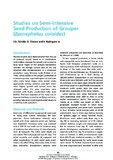Studies on semi-intensive seed production of grouper (Epinephelus coioides)
- Global styles
- MLA
- Vancouver
- Elsevier - Harvard
- APA
- Help
Share
抄録
This study was conducted to improve the hatchery survival of Epinephelus coioides by verifying and incorporating laboratory-scale experimental results to a hatchery-scale operation. Nine units of 200 m2 ponds were used to verify mass culture techniques for zooplankton. Three fertilization schemes were tested with 3 replicate ponds per fertilization treatment. To test copepod production in tanks, adults and copepodids were transferred into 6 production tanks at a density of 60 individuals/litre. Zooplankton in 3 of the tanks were fed daily with Nannochloropsis sp., Tetraselmis sp. and Chaetoceros sp., whereas zooplankton in the remaining 3 tanks were fed daily with half the amount of the mixture of algae and bread yeast. Larval rearing runs were performed from 2000-2002 to verify earlier experimental results. To propagate copepod nauplii in larval tanks, Acartia were inoculated in 4 larval rearing tanks, 2-3 days before stocking of grouper eggs or newly hatched larvae. Brachionus were added daily from day 2 to 18 at increasing densities. Artemia nauplii and metanauplii were fed to satiation from day 15 until metamorphosis. Pond-grown zooplankton was added in separate tanks from day 15 onwards as a supplement to Artemia. The population of copepods in ponds fertilized with various combinations of organic and inorganic fertilizers increased a week after flooding of ponds and fertilization. Zooplankton compositions in the treatments were Apocyclops, Oithona sp., Brachionus rotundiformis, Penilia and Pseudodiaptomus sp. Copepodids and adults of Acartia tsuensis fed a mixture of algae alone or in combination with bread yeast seemed to propagate well in tank conditions. Results suggested that bread yeast could be used in combination with algae for nauplii production of Acartia in tanks. Verification runs indicated that pond-grown copepods could be used as a supplement to Artemia. Larvae fed copepods and Artemia showed similar survival rates to those fed only with Artemia. Larval survival from days 5-15 was higher in larvae reared in 20-25 ppt compared to those reared in normal seawater. 39 out of 71 tanks were discarded in 2000, whereas 3 out of 12 and 8 out of 26 production runs were aborted in 2001 and 2002, respectively. Mean survival at harvest increased from 3.06% in 2000 to 5.33 and 10.39% in 2001 and 2002, respectively. Larvae in discarded or aborted tanks were positive for viral nervous necrosis (VNN).
Suggested Citation
Toledo, J. D., Chavez, D., & Rodriguez Jr., J. C. (2004). Studies on semi-intensive seed production of grouper (Epinephelus coioides). In M. A. Rimmer, S. McBride, & K. C. Williams (Eds.), Advances in grouper aquaculture (pp. 55–60). Canberra: Australian Centre for International Agricultural Research.
Type
Book chapterISBN
9781863204385シリーズ
ACIAR Monograph 110Collections
- Books and Book Chapters [123]


